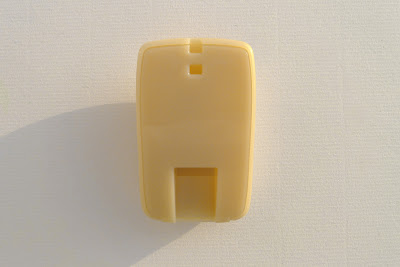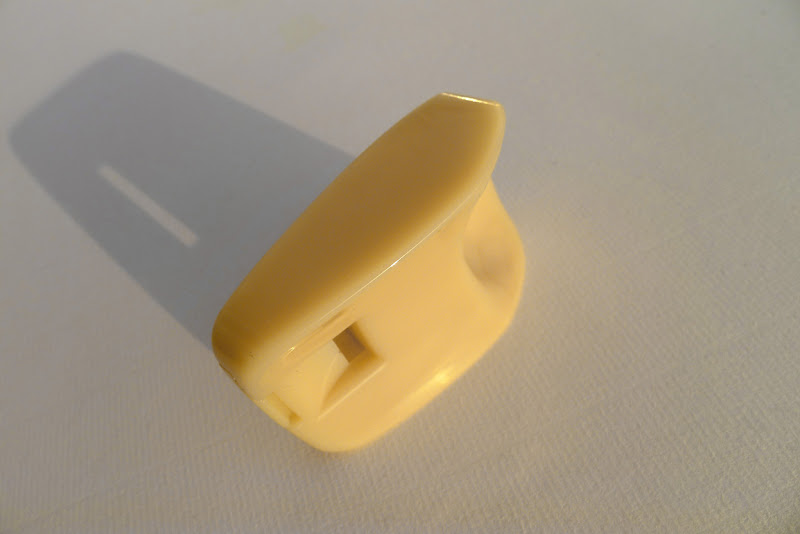
The nose flute « Adachi » (from the name of Mr. Katada's town), in its « Beginner » declination, is born from a pedagogical project. Mr. Mosurin, besides his artistic activities (concerts and recordings), teaches hanabue playing, notably to pupils at school.
Mr. Mosurin's idea was to have nose flutes available, especially designed for children in their dimensions, ergonomic, well working, cheaply priced and providing a certain hygienic quality. Done! And it's a success!
The first images of this project appeared on Mr. Katada's blog Ki_Kanban. In February, Kunio Katada published some first test-prototypes. The design was directly inspired by the wooden nose flute handcrafted by Mr. Katada, and called Adachi. Indeed, despite different dimensions and proportions, the Adachi hanabue is recognizable through the shape of the plastic « Beginner » nose flute.

 |  |

The production (and probably the final design and engineering) was the work of Amuse, Inc. Amuse is a japanese entertainment company, based in Tokyo, « that provides artist management services. The artists include gravure idols, musicians, and so on. Amuse also produces TV & radio programs, commercial films, and movies; other interests are in publication, music software, and patent agent businesses. » (Wiki). For instance, any ukulele player knows the plastic instruments designed by Kazuyuki Sekiguchi and produced by Amuse.
So, compared to the wooden model, the beginner plastic nose flute is smaller and narrower, but with a larger mouth hole, and some supplementary features. It is a beautiful "pebble-style" instrument, made of a very good strong plastic. The color is "butter" and the feel in the hand is very sensual.

 |  |
 |  |

Adachi for beginners is a real technical object. It is made of 2 parts, and for hygienic reasons, the nose flute can be opened and cleaned. When it is opened, the air duct is split in two, and the inside is accessible for cleaning.
This openability feature induced some efforts on the design of the inner shapes:


 |  |


The nose flute also feature a system to receive a neck cord, but has not been planned for handsfree playing, which is understandable, since it's a beginner's flute.
 |  |
The nose saddle is quite comfortable, thanks to its deepness.


On the sound side and playability, the Adachi-beginner reveals itself to be a great player! The tonality range is equilibrated, sharp oriented though. It is easy to produce precise sounds. The airway is short, and the notes are neat, the changes, immediate. Adachi is very sensitive, allowing series of quick notes. Very few air is needed to make the instrument whistle. Any effect, like tremolos or vibratos, are really easy to produce. I must say that this flute is a hi-end instrument.
An adult-sized production is planned, with no date yet. But I found this children model easy to play, even for an adult.
Here is some sound samples:

Great series of pictures, first of all. The flute actually looks as if carved from ivory.
ReplyDeleteThis nose flute has great properties: it looks great and it sounds great, it is easy to assemble and easy to clean: it is the perfect new type of cheaply produceable plastic nose flute!
How wonderful that it was made especially for children, in order to get a new generation to play the instrument! All credits to Mr Katada for having created it and Mr Mosurin for using it in teaching new players.
Thank you Maikel! When the weather is a bit sunny, it helps to take pictures!
ReplyDeleteYes, this nose flute is a very nice achievement, in its goal too.
I am hoping an "adult" version of this instrument --with a (much) longer airway-- will also be created in the same material. This longer airway will allow the lower range to be professionally performed as well. The low range combined with a multitude of wind tones makes the nose flute sound really effective.
ReplyDelete